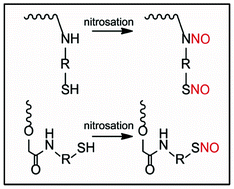Selective nitrosation of modified dextran polymers†
Abstract
The formation of stable nitric oxide (NO) moieties onto

* Corresponding authors
a
Department of Chemistry, Colorado State University, Fort Collins, CO 80523, USA
E-mail:
melissa.reynolds@colostate.edu
Tel: +1 970 491 3775
b School of Biomedical Engineering, Colorado State University, Fort Collins, CO 80523, USA
The formation of stable nitric oxide (NO) moieties onto

 Please wait while we load your content...
Something went wrong. Try again?
Please wait while we load your content...
Something went wrong. Try again?
J. M. Joslin, V. B. Damodaran and M. M. Reynolds, RSC Adv., 2013, 3, 15035 DOI: 10.1039/C3RA41988F
To request permission to reproduce material from this article, please go to the Copyright Clearance Center request page.
If you are an author contributing to an RSC publication, you do not need to request permission provided correct acknowledgement is given.
If you are the author of this article, you do not need to request permission to reproduce figures and diagrams provided correct acknowledgement is given. If you want to reproduce the whole article in a third-party publication (excluding your thesis/dissertation for which permission is not required) please go to the Copyright Clearance Center request page.
Read more about how to correctly acknowledge RSC content.
 Fetching data from CrossRef.
Fetching data from CrossRef.
This may take some time to load.
Loading related content
